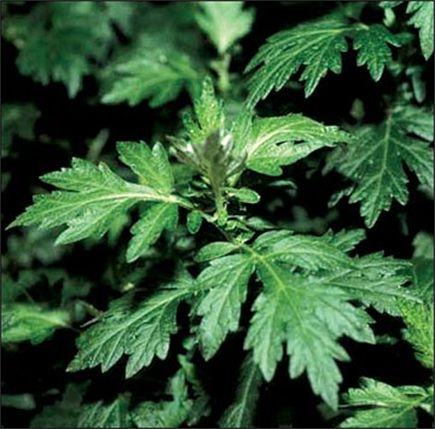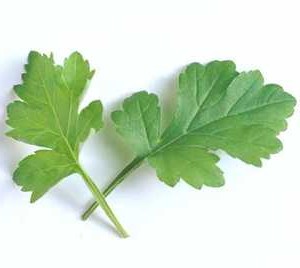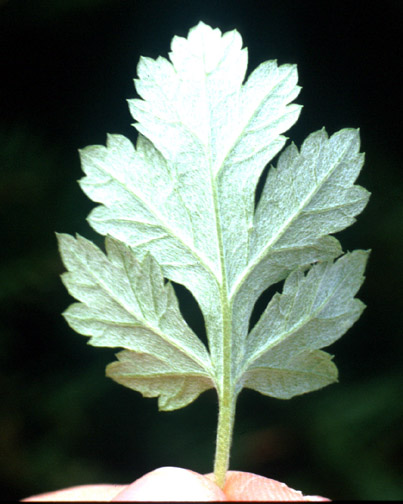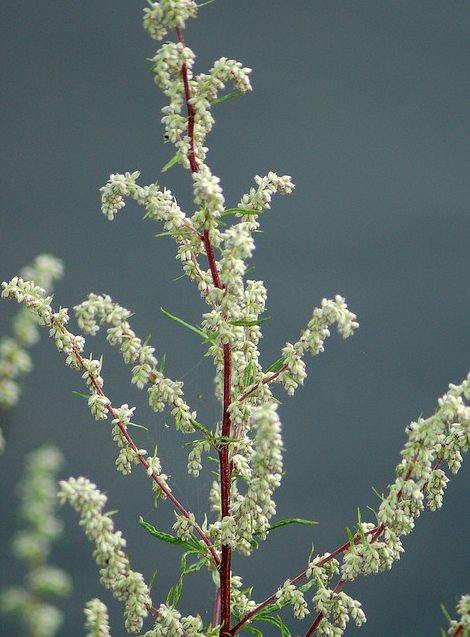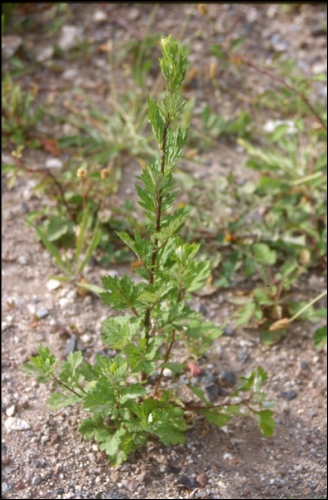Like some other plants with famous relatives Mugwort gets lost in the negative publicity.
Mugwort, Artemisia vulgaris, is completely over shadowed by Artemisia absinthium, the original narcotic ingredient in the liquor Absinthe. I have had the liquorice-like real Absinthe several times in Greece and I have no idea how 1) anyone could like it let alone 2) become addicted to it. It reminds me of extremely bad sweet Ouzo. That bring me to a bit of history.
Decades ago I studied cooking with a retired chef who claimed to have taught Chef Boyardee, Ettore Boiardi 1897 – 1985, the finer art of cooking. (Green Deane has the credentials to cook on ships.) This chef liked the original Oysters Rockefeller which was made with then-banned in the U.S. and still-banned original Absinthe. In his retirement community there was a retired chemist. So these two very old fellows helped each other out. The chemist distilled the Wormwood to add to the sanitized Absinthe and the chef made the original Oysters Rockefeller for them. I often wondered what the headline would have been if they had been arrested for making the illegal dish. Some 40 years later I still use that chef’s (legal) recipe to make Strawberries Romanoff at Christmas. Incidentally the word “Absinthe” comes from the Greek word apsinthion which can mean “undrinkable” a description I totally agree with.
While Mugwort is not as powerful as its genus sibling it has its own chemical calling card: Cinceole, or wormwood oil, thujone, flavonoids, triterpenes and everyone’s favorite rat killer Warfarin aka courmarin also known in medical circles as coumadin. Despite all that the leaves and buds are used as a flavoring or a potherb. There is also an edible cultivar called the White Wormwood or Ghost Plant. It has a floral taste similar to chrysanthemums and is used in soups or fried as a side dish.
A native of Eurasia Mugwort is found in most of North America except the desert southwest and northern plains states. Artemisia vulgaris is said ar-tah-MIZ-ee-ah vole-GAR-us. Vulgaris means common. Artemisia is Dead Latin’s version of a Greek name for wormwood after the goddess Artemis for whom it was sacred. Artemis’ Roman equivalent is Diana. She was the twin sister of Apollo, a goddess of transitions, a hunter, a virgin, and one of the goddesses who assists at childbirth. She also got really irritated with the love affair between Krokus, a human, and Smilax, a wood nymph. Such things were frowned upon. But even in her anger Artemis was romantic. She turned Krokus into the saffron crocus and Smilax into a brambly vine so they could be forever together… ain’t love grand. There are several real people named Artemisias in Greek history but the pronunciation is ar-tah-mah-SEE-ah.
As one might guess the plant has many common names. Among them are: Moxa, Traveler’s Herb, Artemis Herb, Felon Herb, Muggons, Old Man, Sailor’s Tobacco, Motherwort, Greenfinger, Bulwand, Chrysanthemum Weed, and Cingulum Sancti Johamis which means St. John’s Plant not St. Johnswort. Just where “Mugwort” came from is a lingusitic nightmare but the best scholarly guess is “mug” meant “midge” and wort “plant” or midge plant, to ward off insects. Indeed, you can make smudge sticks out of Mugwort.
Take a few branches, arrange into a small bouquet, and lay on it side. With string tie the stem end then wind the string up the bouquet like the stripes on a barbershop pole. Once at the top, wind back down and also tie at the bottom. Take the now bundled branches and roll in something like a sushi mat to tighten the roll. Let dry. Light when needed to keep irritating insects away.
To dry Mugwort for other uses clean branches (without water) and remove dead or damaged leaves. Make into a bundle and tie at the stems. Hang in a dry, dark area for a few weeks.
There are about 19 other Artemisias used in different ways around the world. They include, besides the two already mentioned: Artemisia abrotanum, Artemisia afra, Artemisia annua, Artemisia asiatica, Artemisia dracunculus, Artemisia dracunculus sativa, Artemisia frigida, Artemisia genipi, Artemisia glacialis, Artemisia japonica, Artemisia judaica, Artemisia ludoviciana, Artemisia maritima, Artemisia pallens, Artemisia princeps, Artemisia stelleriana, and Artemisia umbelliforme.
Green Deane’s “Itemized” Plant Profile: Mugwort
IDENTIFICATION: Artemisia vulgaris: Perennial weed with persistent rhizomes, may reach five feet tall, often reddish-brown in color, and become woody with age. Leaves two to four inches long, one to three inches wide, simple, alternate, deeply lobed, and have a distinctive aroma. Leaves on the upper portions of the plant are more deeply lobed and may lack petioles. Leaf undersides are covered with soft, white to gray hairs, while upper leaf surfaces may be smooth to slightly hairy. Flowers are inconspicuous occuring in clusters at the top of the plants. Individual heads are very small and on short stalks. Mugwort looks similar the garden chrysanthemum as well as ragweed seedlings, which lack the distinctive aroma typical of mugwort.
TIME OF YEAR: Flowers summer into fall, greenery available most of the season.
ENVIRONEMENT: Waste ground, roadsides, railroads, fallow agricultural land with a lot of nitrogen still in it, sandy, open ground, prefers lime-rich soils.
METHOD OF PREPARATION: We will let Cornucopia II do that: “young shoots and leaves are an indispensable condiment for fatty poultry such as geese and duck as well as fat pork, mutton, and eel. In Japan they are boiled and eaten as a potherb, or used to give flavor and color to festival rice-cakes… Dried leaves and flowering tops are added to country beer, or seeped into tea. At one time in China the leaves were used for wrapping glutinous rice dumplings eaten during the Dragon Boat Festival.”

